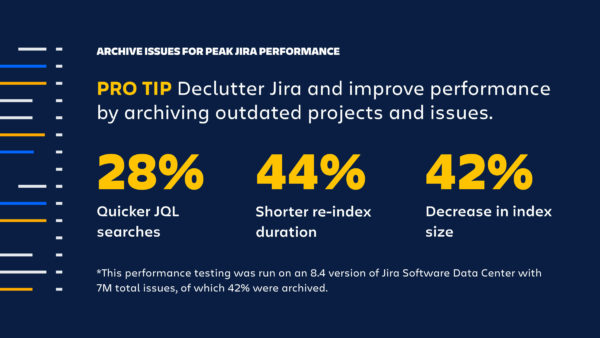Best practices for issue archiving with Jira
Remove out-of-date information from Jira for easier searching and faster performance.
Tune into Netflix lately, and you may find yourself subliminally inspired to clear the clutter in your life. From getting enlightened by a documentary on minimalism to finding zen with Marie Kondo’s KonMari method, simplifying your home by removing the extra clutter is a cultural phenomenon right now that’s, well, sparking joy around the world.
For those of us who strive to maintain a clean and performant Jira, or who use Jira every day to track work, a cluttered space can start to sap the joy from your work life. Much like Celine Dion’s ever-expanding shoe closet, it’s easy to fill your Jira instance to the brim with tickets and projects. Over time, these issues accumulate and grow out of date. This data clutter makes it difficult for you, your teams, and your stakeholders to find what they need. And just like an overfilled drawer that becomes heavier and more difficult to open, your entire Jira instance slows down.
To help you achieve that elusive data hygiene you need at scale, and to make it easier for your teams to find the information they need, we’re introducing issue archiving, a simple but powerful way to remove out-of-date information from Jira for easier searching and faster performance. With issue-level archiving, we’ve doubled down on our native archiving solution in the Data Center editions of Jira Software and Jira Service Desk.
Why we’ve built a robust archiving solution
Before issue archiving, keeping Jira tidy and performant was a complex process for even the most experienced administrators, whose options were:
- Do nothing to remove outdated information and experience infinite Jira growth – at scale, this isn’t an option.
- Manage laborious workarounds like a) changing permission schemas, which hide data, but don’t help performance, or b) exporting projects and issues, which help with performance, but don’t make data discoverable. As one admin told us, “this is really just a pain in the a**”.
Last year, we introduced project archiving, a powerful way to improve the performance of your Jira instance by archiving entire projects. But we know that sometimes you can’t archive whole projects, especially when they’re longstanding projects named after a team or for a continuous function like Support. With issue archiving, we’ve expanded our archiving solution to give you an easy way to archive individual issues, use JQL queries to collect and archive issues as a bulk action, or automate the process through APIs. By archiving, you can create more room for growth and improve performance, without using complex workarounds.
Fast Jira, happy teams
Much like how donating the old clutter packed in your dresser drawers helps you find what you’re looking for much faster, archiving old issues speeds up your Jira instance and helps your users find the work they’re looking for.
We’ve pulled some preliminary numbers to give you a sense of how much your Jira’s performance could improve. Even after the massive performance improvements from the Jira 8.0 platform upgrade, we’ve observed impressive reductions in the time it takes to load backlogs, run JQL searches, and reindex. In our performance testing on an 8.4 Jira Software instance with seven million issues and 43 percent of issues archived, we’ve observed improvements of:
- 9 percent faster loading of backlogs
- 28 percent faster Jira Query Language (JQL) searches
- 44 percent shorter re-index duration
- 42 percent decrease in index size

Overall, we see that Jira’s performance improves linearly with the amount of information that is archived – the more you remove, the greater the performance improvements.
**Please keep in mind, as always, that many factors can impact self-hosted versions of Jira, including network and hardware configurations. Your performance results from issue archiving may vary.
Start going through routine housekeeping
Marie Kondo’s KonMari method dictates that, for each item in your home, you ask yourself: does it spark joy? If not, get rid of it. The question at stake for tidying up your Jira instance is, does it still need to be discoverable? If not, archive it. And don’t worry – that archived data isn’t going anywhere. With admin permissions, you can find it any time, or unarchive for audit purposes as needed.
Here are two easy ways to get started:
- Query for “done” issues that haven’t been touched for the last one to two years, and check with their owners if they’re okay with archiving them.
- Look for old components or released versions without log activity, and again, review with stakeholders to confirm they can be archived.
Archiving issues is very simple, and can be done with one click on the issue itself, or by using JQL queries to collect and archive issues as a bulk action. This video will show you how it works:
Plus, we’ve added the ability to browse archives to help admins find issues to be pulled out of the archive, like during an audit. And for those of you who like to automate processes and dive into code, we’ve released a set of APIs that will make regular archiving easy. Soon, we’ll introduce additional API documentation to make the process more straightforward.
By taking charge of the data in Jira and setting parameters on what should be active or archived, you’ll maintain a healthy instance and extend your runway for years to come.
Archiving best practices
The more your teams collaborate in Jira, the more important it is to future-proof the platform. It’s essential to have a long-term plan for removing outdated information. Here are our top three recommendations for getting started:
- Find the right tool Archiving individual issues allows for more precision, but archiving whole projects gives more performance benefits.
- Archive outdated issues Finding contenders to archive is easy: just go to the projects list and look for large projects which have issues that haven’t been used for the past one to two years. Remember to verify with the owner before archiving it.
- Empower your teams to archive With delegated permissions, Jira users can archive issues as a part of their regular backlog refinement process. They should periodically look at things that are at the bottom of the list, and if they’ve been there for a long time, ask again if it is really worth keeping around. This applies to Product Managers looking at Jira Epics or Product Owners looking at Stories.
By archiving whole projects, individual issues, or parts or projects, you can declutter your instance, improve performance, and create more room for growth.
Upgrade to Jira Software 8.4 & Jira Service Desk 4.4
Issue archiving is available in Jira Software Data Center 8.4 and Jira Service Desk 4.4, and you can read more about what’s new in the Jira Software 8.4 release notes or Jira Service Desk 4.4 release notes before upgrading. And as a reminder, the Jira Software 8.5 and Jira Service Desk 4.5 Enterprise releases are coming soon.
If your team is using Jira Software Server or Jira Service Desk Server and is feeling bogged down by old issues, now may be the time to upgrade to Data Center. With issue archiving, you’ll be able to create more space and unlock resources for data that’s still relevant, making Jira more performant and readable. Start planning your upgrade today.


